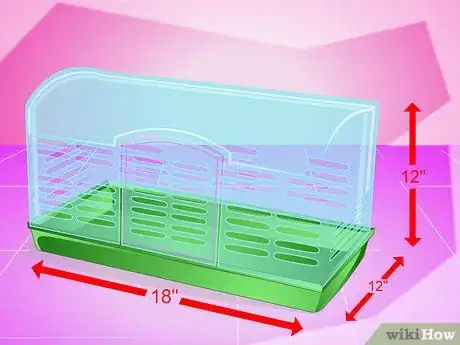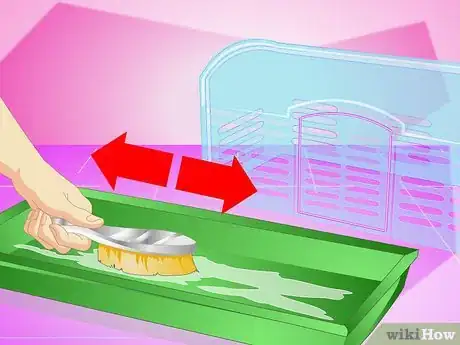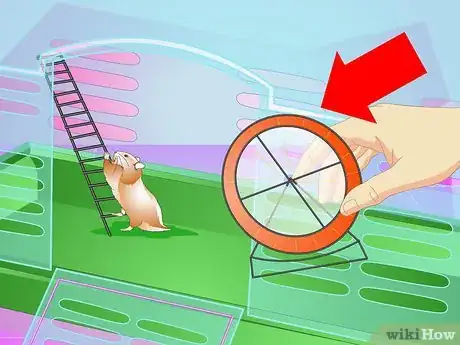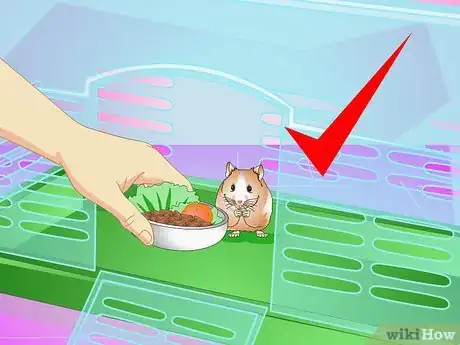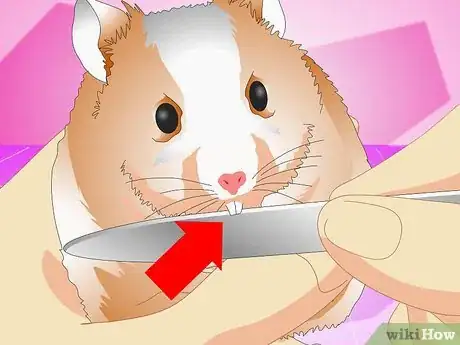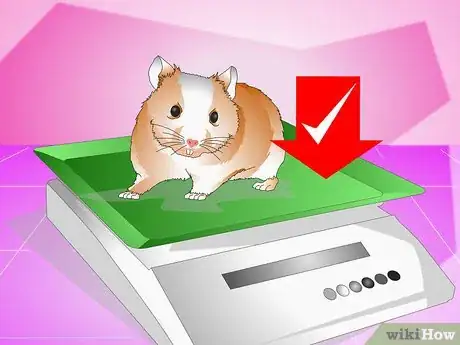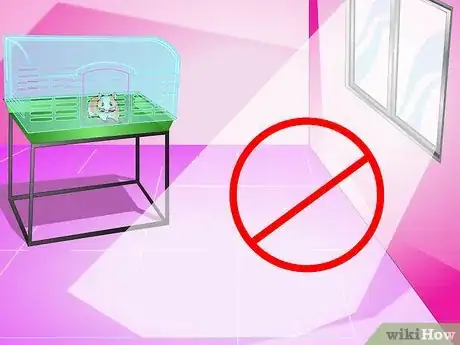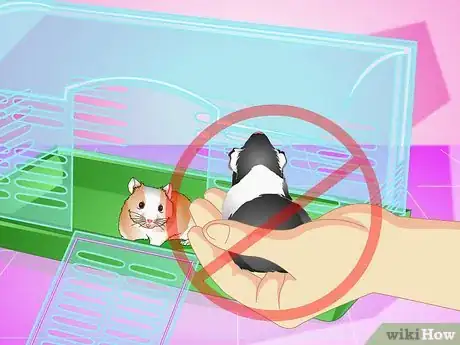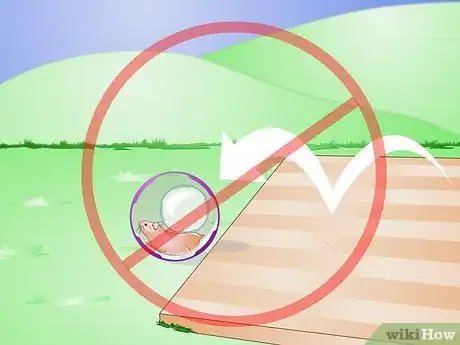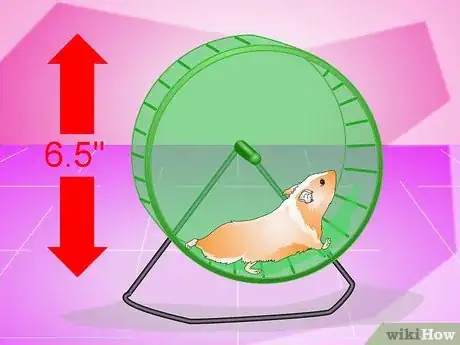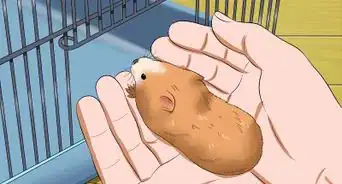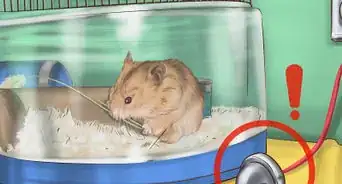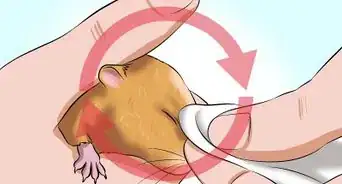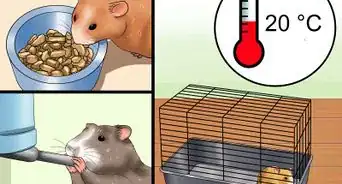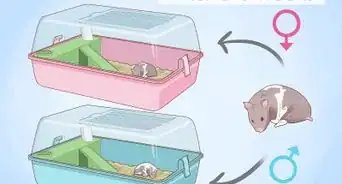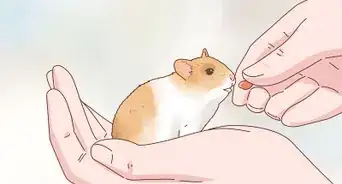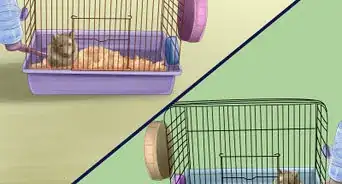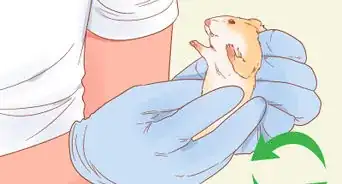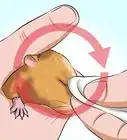This article was co-authored by Pippa Elliott, MRCVS. Dr. Elliott, BVMS, MRCVS is a veterinarian with over 30 years of experience in veterinary surgery and companion animal practice. She graduated from the University of Glasgow in 1987 with a degree in veterinary medicine and surgery. She has worked at the same animal clinic in her hometown for over 20 years.
There are 9 references cited in this article, which can be found at the bottom of the page.
wikiHow marks an article as reader-approved once it receives enough positive feedback. In this case, 84% of readers who voted found the article helpful, earning it our reader-approved status.
This article has been viewed 72,463 times.
On average, hamsters live between two and two and half years. Some breeds may live shorter or longer than this. As people become attached to their pets, you may want your hamster to live longer. There is no surefire way to prolong a hamster's lifespan. However, you can take certain measures to make sure you're giving your hamster as high quality a life possible. This may prolong his life.
Things You Should Know
- Give your hamster a safe and healthy environment with a clean cage, exercise toys, a balanced diet, and plenty of water.
- To ward of potential health issues, take your hamster to the vet every year and when necessary, get its nails and teeth filed down.
- Your hamster will face less health risks if it lives alone in a cage that's out of direct sunlight.
Steps
Providing Food and Shelter
-
1Choose the right cage. Hamsters will live longer in the proper environment. Make sure you provide your hamster a spacious, comfortable cage.
- The size of a hamster's cage is important for his health and wellbeing. A single hamster needs a cage that is at least 12 inches wide by 12 inches high by 18 inches long. However, a bigger cage is generally better. This gives your hamster more room to run and play, allowing him to get more exercise. If you're getting a specific breed, like a Syrian hamster, a bigger cage may be necessary as these hamsters can grow as long as 6 inches.[1]
- In terms of accessories, you will need a bare minimum of a hanging water bottle and a ceramic bowl of food. However, an exercise wheel, toys, ladders, and material for chewing is also helpful to have in a hamster cage. It keeps your hamster active and emotionally stimulated. Boredom can cause stress, leading to health and behavioral problems that can potentially shorten a hamster's lifespan.[2]
- Your cage should be in a warm area of your home. Drafts and cold temperature can cause health problems like colds. However, excessive heat or stuffiness can also bother a hamster. Pick a well ventilated area, which you have access to at all times. Keep your hamster out of direct sunlight and place the cage on a sturdy table.[3]
- Never use newspaper, cat litter, scented bedding, fluffy bedding, or corn cob in a hamster's cage. These substances can be harmful to your hamster.[4]
-
2Clean the cage regularly. Hamsters can get sick if they're forced to walk through their own droppings or germs. It's important that you clean your hamster's cage at least once a week if you want him to live a long, happy life.
- Always remove your hamster from his cage before cleaning. Place him in a safe and secure area.[5]
- Remove all bedding, toys, food bowls, and water bottles. Throw away old bedding that has urine or feces on it. Any toys that cannot be safely cleaned or disinfected should also be thrown out.[6]
- You can use regular cage disinfectant, which you can purchase at a pet store. While this should be safe for your hamster, if you worry about chemicals white vinegar can be used to clean your hamster's cage. Spray down the cage, getting the bottom of the cage, top of the cage, and bars of the cage, and then wipe it down with a clean towel. You should also disinfect a hamster's toys, food bowl, and water bottle. Make sure to rinse such items thoroughly before placing them back in a hamster's cage.[7]
- Allow the cage, and your hamster's supplies, to air dry completely before putting your hamster back in his cage.[8]
Advertisement -
3Make sure your hamster gets exercise. Obesity and inactivity can cause health problems in hamsters just as it can in humans. It's important that you make sure your hamster is getting plenty of exercise so he'll live longer. Make sure the environment you provide for your hamster encourages physical activity.
- Running wheels and ladders to climb on are great ways to make sure your hamster gets a quality workout each day. Go to your local pet shop, or go online, and purchase a variety of fun and interactive toys for your hamster that encourage movement.[9]
- Plastic tubes can be purchased for a hamster's cage. Some people invest in a second cage and have the cages connect to one another via a tube. Your hamster will have fun exploring the tubing and this will give him something to do all the day. The more your hamster moves, the better for his longterm health.[10]
- You can purchase a hamster ball at a local pet store. This is a small plastic device you can place your hamster in and then let him wander around your home. Make sure the hamster ball is closed completely before releasing your hamster and always supervise him when he's using his ball.[11]
-
4Feed your hamster a balanced diet. Hamsters need a specific diet in order to thrive. Feed your hamster a combination of table food and hamster pellets to make sure he gets all the nutrients he needs. This will allow your hamster to live a long, quality life.
- Pellets should be a major aspect of your hamster's diet. You can find commercial pellets at your local pet store. They should provide most of the nutrients your hamster needs to be healthy. However, if you're unsure that commercial pellets are adequate ask your vet about adding vitamins to your hamster's diet. Many hamster owners find mixing vitamins into their hamster's food improves their pet's overall health.[12]
- In addition to pellets, you should add fresh produce to your hamster's diet. Alfalfa sprouts, apples, bananas, green beans, zucchini, sunflower seeds, and other grains and veggies can be a great supplement to a hamster's regular diet. However, do not give your hamster rotten food. This can cause indigestion and other health problems.[13]
- Hamsters tend to eat fattier, tastier foods from a pile first. For example, they may eat all their sunflower seeds without touching their fruit. This is normal but do not take it as an indication you should feed your hamster more sunflower seeds. You need to make sure your hamster has a balance of healthy foods in addition to fun snacks and treats. Moderation is key to a healthy, happy pet.[14]
-
5Provide plenty of water. In addition to food, hamsters need plenty of water. Make sure you refill your hamster's water bowl each day. You should also dump out water every other day or so and replace it with clean, fresh water.
- If your hamster seems to be drinking an excessive amount of water, take him into the vet for evaluation. Increased water consumption can be a sign of diabetes in hamster.
Preventing Health Problems
-
1Watch for signs of poor health. You should check your hamster periodically for signs of poor health. Most medical problems are easier to treat if they're caught early on. Once a week, inspect your hamster to make sure he's in good health.
- Check your hamster's nose and eyes. Both should be clear and free of discharge. Hamsters are prone to colds. If your hamster seems to be getting colds often, you may need to move his cage into a warmer part of the house. Hamsters are prone to eye infections and chronic eye problems like glaucoma. If you notice tearing, unusual discharge, or droopy and swollen eyelids take your hamster to a vet for evaluation.
- As your hamster ages, his fur may grow thinner and he might develop bald spots. This is normal. However, if you have a younger hamster who's developing flaky skin, bald spots, matted fur, or rashes take him to the vet for evaluation.
- Check your hamster for lumps each week. Hamsters are prone to benign skin growths but, in rare cases, new lumps can be cancerous. The sooner a cancerous lump is removed, the better chance your hamster has of recovery. If you notice a new growth on your hamster, make a vet appointment as soon as possible.
-
2Take your hamster to the vet when necessary. When it comes to hamster health, prevention is always better than treatment. Take your hamster to the vet for a checkup at least once a year. In addition to yearly check-ups, a vet appointment might be necessary if you notice certain changes in your hamster's behavior or appearance.
- Any sudden changes can be a sign your hamster is not feeling well. If your hamster gains or loses weight quickly, has any changes in energy, or seems disinterested in normal activities make an appointment with your vet.
- Keep an eye on your hamster's rear end. If you notice staining or stools suck to the fur around your hamster's anus, he may have digestive issues that need evaluation. If you notice a pungent smell coming from your female hamster, check for discharge on the area above her anus. Females are prone to infections of the womb that require fast medical intervention.
-
3Keep your hamster's nails and teeth filed down. Check your hamster's teeth and nails once a week. Your hamster's teeth should be yellow and the bottom teeth should be longer than the top. Nails should be long without curving inward. Long teeth or nails can cause irritation and may even puncture your hamster's skin, resulting in health problems. If your hamster's teeth or nails seem overgrown, make an appointment with your vet to have them trimmed.
-
4Help your hamster maintain a healthy weight. A healthy weight is important for your hamster. Hamsters generally gain weight until the age of 6 months. Their weight should be relatively stable until they reach 18 months. At that point, your hamster's weight will start decreasing slightly each month. Weight changes between 6 and 18 months may be a sign something is wrong.
- If your hamster is gaining weight, talk to your vet about his diet. You may need to find a different brand of pellet or cut back on his treats. If a change in diet does not result in weight loss, your vet may want to test your hamster for medical conditions that may be causing weight gain.
- If your hamster is losing weight, take him to the vet for evaluation. A variety of health problems can cause weight loss or loss of appetite in a hamster. Early detection can help provide more effective treatment for your hamster.
Avoiding Accidents
-
1Keep your hamster's cage in a safe place. You should keep your hamster's cage in a secure place away from direct sunlight. Do not keep your hamster's cage in an area where small children or other pets may get at the cage. If a cage is knocked over or otherwise damaged, this could be deadly for your hamster.
- Read reviews before purchasing a hamster cage. Not all hamster cages are created equal. If a lot of buyers report problems with a particular brand, go for a different option.
-
2Allow your hamster to live alone. Hamsters are territorial and do not get along with other hamsters, so it is best to let your hamster have his own cage. Introducing a new hamster to your hamster's cage may stress him out and they may end up fighting. Stress can cause health problems and fights can lead to injuries, both of which can shorten a hamster's lifespan. If you have to introduce a second hamster for some reason, do so gradually.
- If you get a new hamster, make sure it's of the same sex as your current hamster. Hamsters are very fertile and may breed if placed in the same cage as an opposite sex partner.[15]
- You should introduce a hamster to a new friend when he's still relatively young. Suddenly adding a new hamster when your hamster is a senior can be jarring.[16]
- Keep hamsters in separate cages where they can see one another for about a week. Then, place them in the same cage. If they fight, separate them gently and allow them time to cool down before reintroducing them. Wear protective gloves when handling fighting hamsters, as they may scratch and bite when scared.[17]
-
3Do not let your hamster out of his cage unsupervised. Many people allow hamsters to roam their homes freely in a hamster ball. This can be a great way to exercise your hamster. However, a hamster should never be allowed to roam a house unattended. Hamsters can get caught in nooks and crannies in your home, roll down the stairs, or even accidentally get out of the house. If you use a hamster ball, make sure you supervise your hamster when he's using the ball.[18]
-
4Choose the right wheel. A wheel that's too small can cause injury and back pain for your hamster. This could limit his movement and discourage him from exercising. At minimum, the wheel you purchase should be 6.5 inches. Larger hamsters need wheels of at least 8 inches. It's better to have a wheel that's too big than too small, as a small wheel forces a hamster to arch his back. This is what leads to injury.[19]
Warnings
- Hamsters can pick up certain illnesses from humans, so, if possible, try to avoid handling your hamster when you are sick with a cold.⧼thumbs_response⧽
References
- ↑ http://www.smallanimalchannel.com/hamsters/hamster-housing/ideal-hamster-cage.aspx
- ↑ http://www.smallanimalchannel.com/hamsters/hamster-housing/ideal-hamster-cage.aspx
- ↑ http://www.smallanimalchannel.com/hamsters/hamster-housing/ideal-hamster-cage.aspx
- ↑ http://myspet.com/6-hamster-bedding-mistakes-everyone-made/
- ↑ http://animals.mom.me/disinfect-hamster-cage-1484.html
- ↑ http://animals.mom.me/disinfect-hamster-cage-1484.html
- ↑ http://animals.mom.me/disinfect-hamster-cage-1484.html
- ↑ http://animals.mom.me/disinfect-hamster-cage-1484.html
- ↑ http://www.pethealthnetwork.com/all-pet-health/small-animal-health-care/top-10-ways-keep-your-hamster-healthy/page/0/4
- ↑ http://www.pethealthnetwork.com/all-pet-health/small-animal-health-care/top-10-ways-keep-your-hamster-healthy/page/0/4
- ↑ http://www.pethealthnetwork.com/all-pet-health/small-animal-health-care/top-10-ways-keep-your-hamster-healthy/page/0/4
- ↑ https://pethamstercare.com/food-diet/
- ↑ https://pethamstercare.com/food-diet/
- ↑ http://www.pethealthnetwork.com/all-pet-health/small-animal-health-care/top-10-ways-keep-your-hamster-healthy
- ↑ http://www.pethealthnetwork.com/all-pet-health/small-animal-health-care/top-10-ways-keep-your-hamster-healthy/page/0/4
- ↑ http://www.pethealthnetwork.com/all-pet-health/small-animal-health-care/top-10-ways-keep-your-hamster-healthy/page/0/4
- ↑ http://animals.mom.me/hamsters-good-other-hamsters-1139.html
- ↑ https://petcentral.chewy.com/hamster-ball-tips/
- ↑ https://petsinomaha.com/how-to-choose-the-best-hamster-wheels/13166
